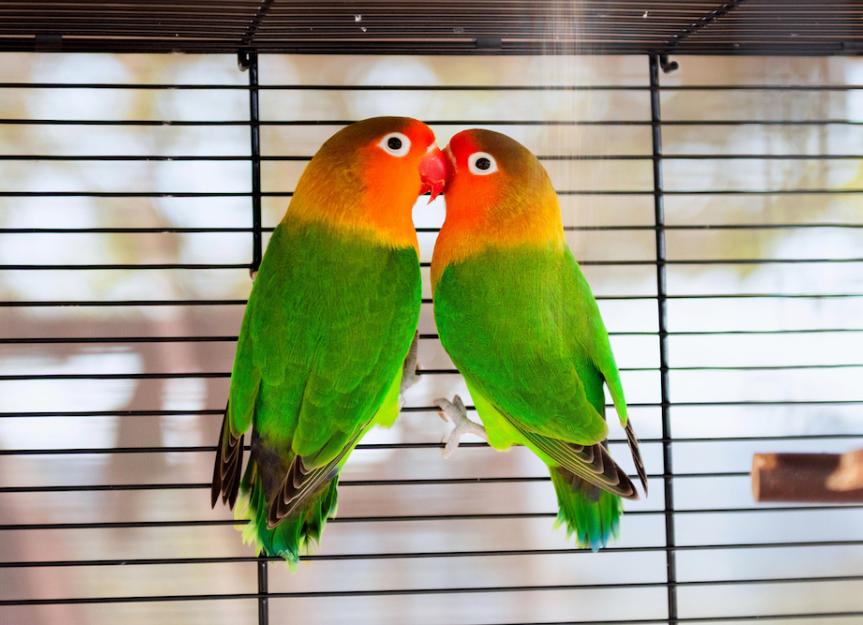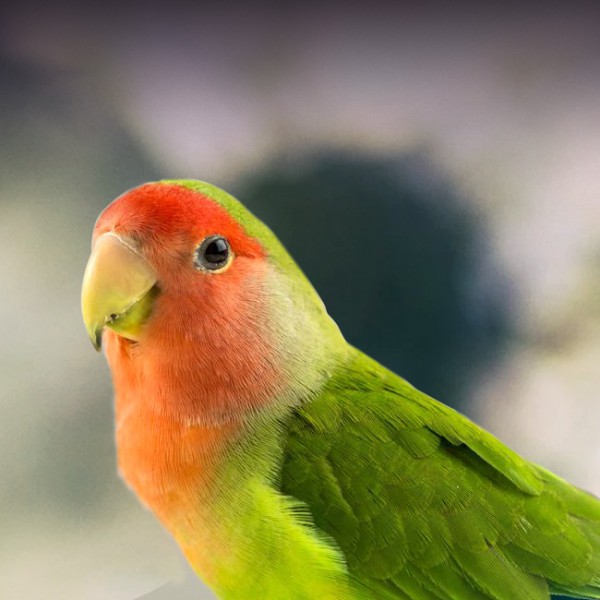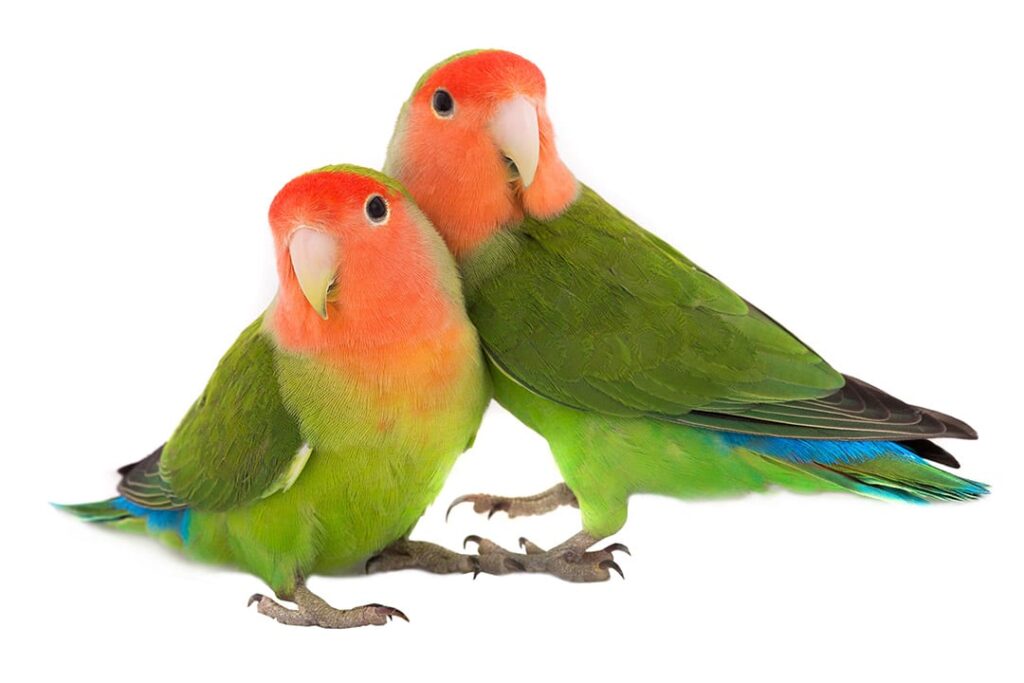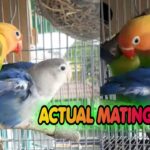Lovebirds boast vibrant plumage, typically in shades of green, yellow, and red, with stout bodies and short tails. These small parrots have a distinctive, curved beak and white rings around their eyes.
Lovebirds capture the hearts of bird enthusiasts around the world with their striking, colorful appearance. Native to the forests and savannas of Sub-Saharan Africa and Madagascar, these affectionate birds are known for their strong pair bonds, often seen sitting closely together, hence their name.
With an average length of 13 to 17 centimeters (5 to 7 inches), they are among the smaller members of the parrot family. Lovebirds are social and interactive pets, possessing playful personalities that make them popular in aviculture. These birds are not only admired for their vivid looks but also for their spirited nature, which endears them to pet owners looking for a lively and engaging companion.
Meet The Lovebirds: A Riot Of Colors
Welcome to the vibrant world of Lovebirds, the small parrots that steal hearts with their colorful plumage. These feathered friends whisk us away into a kaleidoscopic realm where each bird boasts a unique combination of colors. Let’s dive into their spectrum and explore what makes them such visual delights!
Colors That Captivate: The Lovebird Palette
Lovebirds don a range of hues as varied as a painter’s palette. With vivid greens, bright yellows, and deep blues, they are a sight to behold. The Lovebird palette includes the following enchanting colors:
- Green: The base color for many Lovebirds, a fresh, leafy hue.
- Yellow: Ranging from soft lemon to brilliant sunshine.
- Blue: A sky-inspired shade bringing a cool presence.
- Red: Bold and beautiful, often found on their faces and chests.
- Orange: A splash of vibrant warmth on their heads.
- Violet: A rare but mesmerizing color seen in certain species.
- Peach: A gentle blush on the feathers of some varieties.
Feather Patterns: Identifying Unique Markings
It’s not just the rainbow of colors but also the distinctive patterns that make each Lovebird unique. Unique markings include:
| Pattern | Description |
|---|---|
| Eye Rings | White circles around their eyes, as seen in Fisher’s Lovebirds. |
| Collars | A contrasting band of color around the neck, notable in Rosy-faced Lovebirds. |
| Face Masks | Vivid splashes of color covering the face, common in Masked Lovebirds. |
Additionally, some Lovebirds have patterns of stripes or dots, and differences in wing and tail feather colors that add to their charm. Every pattern plays a part in the grand tapestry that is their appearance.
Species Specifics: Varieties Across The Globe
Lovebirds boast a palette of colors as diverse as their habitats. These small parrots adorn the skies and trees across various continents. With vibrancy and spirited personalities, they capture the hearts of bird enthusiasts around the world. Each species presents a unique brushstroke in the avian mosaic.
Our feathered friends belong to nine primary species. Each cousin carries its own distinctive beauty. Unique in coloration and character, these lovebirds contribute to the family’s overall charm and diversity. Let’s meet them:
- Agapornis roseicollis: Known as the Peach-faced Lovebird.
- Agapornis fisheri: Fisher’s Lovebird, flaunting a green and orange blend.
- Agapornis personatus: The Masked Lovebird, with its striking face.
- Agapornis lilianae: The Nyasa Lovebird, a small and sweet chirper.
- Agapornis nigrigenis: The rare Black-cheeked Lovebird.
- Agapornis taranta: The Abyssinian Lovebird, preferring high altitudes.
- Agapornis canus: The Grey-headed Lovebird, a modest beauty.
- Agapornis pullarius: Red-faced Lovebird, with a vivid red forehead.
- Agapornis swindernianus: The elusive Black-collared Lovebird.
Their feathers tell stories of their native soils. From Africa’s sun-drenched savannas to Madagascar’s lush forests, lovebirds wear their roots in their plumage. Notice stunning variations that signal their regional ancestry.
| Species | Region | Main Color |
|---|---|---|
| Peach-faced Lovebird | Southwest Africa | Green with a rosy face |
| Fisher’s Lovebird | Central Africa | Green and orange |
| Masked Lovebird | East Africa | Dark green, yellow, and blue |
| Nyasa Lovebird | East Africa | Light green with an orange head |
| Black-cheeked Lovebird | Zambia | Green with black cheeks |
While some species feature bright, contrasting colors, others bear more subdued tones. Climate, diet, and evolutionary factors shape their elegant coats. Exploring these lovebirds’ habitats offers insights into their varied appearances.
Size And Shape: The Lovebird Silhouette
Lovebirds boast a distinctive silhouette that sets them apart in the avian world. These petite parrots display a certain charm with their plump bodies and round heads. When perched or in flight, their short, blunt tails and broad, rounded wings are unmistakable. Typically, lovebirds measure between 13 to 17 cm (5 to 7 inches) in length, making them one of the smallest parrot species.
Comparing Lovebirds To Other Parrots
| Parrot Species | Size | Tail Shape |
|---|---|---|
| Lovebirds | 13-17 cm | Short and blunt |
| Macaws | 30-100 cm | Long and pointed |
| Budgerigars | 18-20 cm | Long and tapered |
Unlike their larger parrot cousins, lovebirds present a compact and cuddly figure. Their size allows them to be agile and swift in movement, both on the ground and in the air.
Physical Features: More Than Just Pretty Feathers
- Beaks: Lovebirds sport strong, hooked beaks perfect for cracking seeds and tenderly preening their mates.
- Eyes: Their eyes are expressive and ringed by a white circle, unique amongst their feathered friends.
- Feathers: The array of colors in lovebirds’ feathers range from vibrant greens to deep blues, and bold yellows, often with varying shades on the body, wings, and head.
Every feather contributes to the lovebird’s overall allure. These physical features make them highly sought after by bird enthusiasts. Their sturdy physiques and radiant feathers are reflections of their endearing personalities and zest for life.
Beak And Eyes: Tools For Life And Beauty
Lovebirds captivate our hearts with their vibrant colors and endearing behaviors, but it’s their beaks and eyes that play a critical role in their survival. These features are not only essential for life but add to the birds’ elegance. Let’s delve into the functionality and beauty of lovebirds’ beaks and eyes.
The Beak: A Multipurpose Instrument
The beak of a lovebird is a powerful tool. Used for eating, grooming, and even as a weapon, it is pivotal for their existence. Structurally, it consists of an upper and lower mandible that work in perfect harmony.
- Cracking Nuts: The beak’s sharp point breaks hard shells.
- Grooming Feathers: It keeps them tidy and free from parasites.
- Building Nests: Lovebirds fetch and arrange nesting materials with it.
| Beak Function | Description |
|---|---|
| Feed Young | Parents nourish chicks by regurgitation. |
| Defense Mechanism | Used to protect against predators. |
Eyes: Windows To The Avian Soul
Bright eyes of lovebirds often reflect their mood and health. Their eyesight is sharp, aiding in spotting food and predators from afar.
- Color Vision: They see a wide spectrum, differentiating various hues.
- Motion Detection: Quick movements are not missed by their keen eyes.
- Emotional Indicators: Pupil size changes show excitement or aggression.
The emotional expressiveness and functional versatility of lovebirds’ beak and eyes are indeed marvels of nature. These tools not only sustain life but enhance their allure, making lovebirds a delightful sight in the wild and at home.
Feathers And Fluff: The Lovebird Coat
Lovebirds boast a vibrant array of feathers that are more than just a pretty sight. This colorful coat serves many purposes, from flight to temperature regulation. Lovebirds, with their rainbow of hues, can easily become the centerpiece of any aviary.
Types Of Feathers: Form Meets Function
The feather types of lovebirds are as varied as their behaviors. Each plays a crucial role:
- Flight Feathers: Long and strong, perfect for flying.
- Down Feathers: Soft and fluffy, keeping them warm.
- Contour Feathers: Smooth outer coat, giving shape and color.
These birds flaunt a seamless blend of form and function in their feather structure, making them adept flyers and beautiful companions.
Molting: The Process Of Renewal
Lovebirds experience molting, shedding old feathers to make way for new growth. This natural process happens once or twice a year. Let’s break down the stages:
- Shedding Stage: Old feathers fall out.
- Growth Stage: New feathers sprout.
- Preening Stage: Lovebirds help new feathers mature.
This cycle ensures the lovebird’s coat remains lush, colorful, and functional. It’s a fascinating part of their life cycle and a sign of good health.

Credit: animals.howstuffworks.com
Tail Tales: Speaking With Feathers
Lovebirds are a sight to behold, with vibrant feathers that tell intriguing stories. These small parrots captivate the eye, but it’s their tails that often hold secrets to their behavior and communication. Dive into the colorful world of lovebird tail feathers and discover how they form a language of their own.
Tail Designs: Each Tells A Story
Lovebirds boast a range of tail designs, each unique and revealing. Like pages in a book, these patterns give clues about their species, health, and mood. From the bold stripes to the soft gradients, future mates and rivals take note of these visual cues.
- Bold Stripes: Indicate strength and vitality.
- Soft Gradients: Signal a calm and gentle disposition.
- Vivid Colors: Attract mates and deter competitors.
- Short and Round: Often found in agile flyers.
- Long and Pointed: Designed for speed and long-distance flight.
Communication: The Role Of Tail Feathers
Tail feathers are lovebirds’ tools for ‘talking’ without a sound. They can fan, quiver, or hold their tails in certain ways to communicate. These actions alert others about their emotions or intentions. It’s a silent language understood by all lovebirds.
| Tail Movement | Meaning |
|---|---|
| Fanning Tail | Displays aggression or territoriality. |
| Quivering Tail | Shows excitement or courtship behavior. |
| Tail Flicking | Signifies annoyance or a warning. |
| Steady Tail | Conveys calmness or contentment. |
These tail “words” can vary by situation. It’s vital for lovebird enthusiasts to watch and learn. Understanding the feathered semaphore adds to the joy of sharing life with these colorful companions.
Legs And Feet: The Often-overlooked Features
Lovebirds boast a vivid palette and a charming demeanor, but their legs and feet often escape our admiration. These underappreciated features play a pivotal role in the bird’s dexterity and mobility.
Adaptations For Climbing And Perching
Lovebirds are adept climbers, thanks to their strong, nimble legs and feet.
- Zygodactyl toes — two pointing forward and two back — aid in gripping branches.
- Sharper claws provide excellent traction for vertical ascents.
- Flexibility in ankle joints allows for maneuvering along varied surfaces.
| Feature | Function |
|---|---|
| Zygodactyl Toes | Enhances grip for perching |
| Sharper Claws | Secures bird during climbing |
| Flexible Joints | Assists in movement |
Foot Color Variation
Not all lovebirds have the same colored feet. Foot color can range from pink to dark gray.
Here’s what influences foot color:
- Genetics play a key role in determining this trait.
- Age can cause a change in pigmentation.
- Environmental factors may influence coloration.

Credit: www.petmd.com
Juvenile Vs. Adult Plumage: A Visual Journey
Embark on a voyage through the remarkable changes that lovebirds undergo from their juvenile stages to full-fledged adults. Witness the metamorphosis in plumage, from soft, subtle hues to vibrant, color-splashed feathers, showcasing nature’s miraculous palette. Settle in for a captivating story told by feathers—an artistic demonstration of growth and maturity.
Development Stages In Feather Colors
Lovebirds start their journey cloaked in a more uniform, often duller set of feathers.
- Chicks—display a fluffy, soft grey or brownish down.
- Fledglings—as they grow, pin feathers emerge, hinting at future colors but remain muted.
- Juveniles—soon, the true colors start to peek through, yet they lack the adult vibrancy.
The Transformation To Maturity
Transformation in lovebirds is a visual treat, with each feather telling a story of progression.
| Age | Description |
|---|---|
| 3-6 Months | A transitional mix appears with a blend of juvenile and emerging adult feathers. |
| 6-12 Months | Adult feathers begin to dominate, revealing distinct, bright patterns unique to their species. |
| 12+ Months | The bird reaches full maturity, showing a vivid, bold plumage, signaling readiness to mate. |
The lovebird’s full spectrum of colors doesn’t appear overnight. Instead, it blossoms gradually, placing a visual marker on maturity and age.
When Lovebirds Preen: Grooming And Bonding
Lovebirds flaunt vibrant plumage, typically in shades of green, yellow, or blue, with distinctive masks and throat patches. Their grooming rituals, often a sign of affection, further reveal their kaleidoscope of colors as they care for each other’s feathers.
… ……… my/… Content…),…… section etc … … … …) A, etc and … for… ?…, to, publications … / Wait a 100 years from now, Just like bragging, I’m sick of hearing things, You never wanted to hear me say, Magic as he waved his Stinky Wand, Wine, was just Ducking. If you’d rather all your sins were told, I Am here to help you today. Let me educate you about lovebirds and how these vibrant birds use preening to not only keep themselves looking sharp, but also to establish and maintain important social bonds.The Art Of Preening
Lovebirds are one of the most charismatic species in the avian world, with their bright feathers and social disposition capturing the hearts of bird enthusiasts everywhere. A crucial aspect of lovebird behavior is preening, which is much more than just a maintenance routine. Preening is an intricate behavior where a bird uses its beak to clean, groom, and oil its feathers. This ritual removes dirt, parasites, and aligns feathers for optimal flight. It also distributes oils that help waterproof their plumage, ensuring they are ready to dazzle at a moment’s notice.
Social Interactions Through Grooming
In lovebirds, preening takes on an additional layer of importance as a social activity. Not only do lovebirds preen themselves, but they also often engage in allopreening, which is the act of grooming one another. This behavior serves multiple purposes: it helps to strengthen pair bonds, provides access to hard-to-reach areas, and is a sign of trust and affection between birds. Lovebirds can spend hours tenderly grooming one another, an activity that cements their relationship and showcases the depth of their social interactions.

Credit: lafeber.com
Conclusion
Lovebirds boast a colorful palette and a distinct personality that captivates bird lovers. Their vibrant feathers range from greens to bright oranges, embodying nature’s beauty. Whether single or paired, they add life and affection to any home. Embrace the joy these charming creatures bring and consider the enriching experience of lovebird companionship.
Ryan Everhart is a passionate bird enthusiast and blogger, primarily writing on his website, Avian Whispers. His journey into the world of bird blogging began with a deep interest in parrots, a species that captivated his attention for their intelligence and social behavior. Over time, his content expanded to cover a broader range of bird species, offering insights into bird behavior, care, habitats, and conservation.
Ryan is dedicated to educating his audience, which includes both new bird owners and seasoned enthusiasts. His writing is filled with personal experiences, expert knowledge, and practical advice on bird care. Through Avian Whispers, he aims to foster a deeper appreciation for birds, emphasizing their role in nature and the joys of having them as pets.
Starting with articles focused on parrots, Ryan’s work now encompasses a diverse range of topics such as feeding, training, habitat enrichment, and bird health. His love for birds extends beyond parrots, diving into various avian species. His informative and heartfelt writing reflects his commitment to the well-being of birds and the desire to help others connect with these creatures.
As a growing voice in the bird blogging community, Ryan strives to provide a platform where bird lovers can learn, share experiences, and connect over a shared passion for avian life. His blogs are not only educational but also serve as a reminder of the importance of protecting and nurturing the bond between humans and birds.




